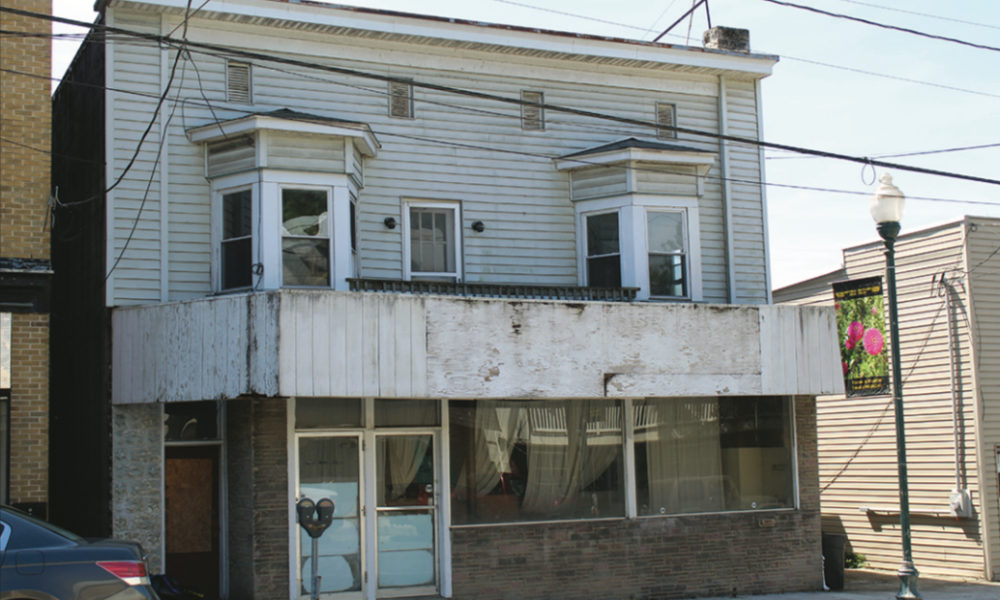by Geoff Fox
Town officials held a workshop last Monday, August 29, to discuss the Urban Renewal Authority house bill and a possible ordinance that could help enforce the repair and clean up of Hancock’s Main Street.
Because it was a workshop, officials did not make any decisions except to set a public hearing prior to the September 13 town meeting and voting on the ordinance at the same meeting.
House Bill 543 was passed by the Maryland Assembly on March 13 and grants the Town of Hancock “the authority to exercise urban renewal powers in areas zoned for commercial use for blight clearance and redevelopment under Article III, Section 61 of the Maryland Constitution.”
For HB543 to take effect in Hancock, town officials have to create an Urban Renewal Authority that would have the right to set up a program and create the parameters of a renewal effort.
Town Advisor Bill Valentine gave town officials three packets to consider related the effort – HB543, a proposed Nuisance and Abandoned Property Abatement ordinance, and an Urban Renewal Plan.

The proposed ordinance presented to Hancock councilmen was from Hagerstown, and according to Valentine, “passed muster” since it’ s on the books there.
The only difference, Valentine said, between Hancock’ s ordinance and Hagerstown’ s would be the name of each town.
“The nice thing about this ordinance,” Valentine said, “is it gives a very clear definition of abandoned property and unusable property.”
The proposed ordinance also describes the powers and duties of the department. In the case of Hagerstown, that is the Planning and Code Administration Department.
During the discussion, town officials didn’t specify which body in Hancock would act as the department in charge of determining which properties in town could be considered a “nuisance” or abandoned, and work with property owners to clean up any trouble areas.
The department would negotiate settlement agreements with the owner or owners of those properties for the purpose of requiring the owner to repair and rehabilitate properties over a term of no more than six months; demolish the properties; or transfer legal title of the property to the town.
Valentine said if violations are observed, those violations are recorded and sent to the owner, who would have 30 days to repair those violations.
If those repairs were not done within the 30 days, the town could take the owner to court. The owner then could forfeit the property, tear down the building, or sell the property.
If the owner would not want to do so, a settlement is not reached between the town and owner, a third part would come in and evaluate the property as is with the town would then have the right to purchase the property.
The town wouldn’t hold on to that property but put out a request for proposal.
After the meeting, Valentine described the RFP process as being what would benefit the town.
Councilman Roland Lanehart, Jr. said there would have to be a system put in where a person putting in an RFP would have to buy the building as is and where is instead of the town spending money tearing down the building.
Valentine said tearing down a nuisance or abandoned building would be the last thing the town would want to do.
The town is set to receive $1 million from the state of Maryland for urban renewal efforts “if they play their cards correctly,” Valentine said. They could possibly receive $1 million next session as well.
To get that money, the town has to take several steps, including passing a Nuisance and Abandoned Property ordinance, establishing the boundaries of the town’ s Urban Renewal efforts and creating an Urban Renewal Plan with input from property owners and residents.
Under the full plan, Valentine listed 16 objectives for urban renewal in Hancock.
Among those are:
—To work with citizen’s advisory committees and subcommittees for maximum input and evaluation of development recommendations;
—to prevent further fragmentation of central core area retail and office development activity;
—to improve pedestrian flow and protection for pedestrians between retail activities, offices, public facilities, parking, and related areas, through improvements at street level as well as grade-separated pedestrian ways;
—to encourage the development of, and provide sites for, additional retail uses, including department stores; and
—to encourage private restoration, rehabilitation, development, both within and adjacent to project areas, through public improvements in project areas.
Some spots “deplorable”
Valentine said there are at least 10 buildings in “deplorable condition” along Main Street where the owners aren’t willing to do anything with those buildings.
“So we’re going to have to give them a nice gentle nudge,” he said.
One building, which Valentine said is owned by Kenny Apple, is in disrepair where walkway across the roof and a hole in the roof. He also pointed out people tend to get in the building as well.
“There’ s nothing secure about the building,” he said.
Lanehart said he had Public Works screw a door on the building and it continually gets kicked in.
Other buildings have a mold problem and trees growing inside.
Lanehart added he didn’t want the town in the realty business, should they have to take one of the properties.
If the town takes control of a building, the previous owner would be on the hook for any mold remediation. Valentine said it would be via court orders to have the owners pay for that repair.
Town officials also had to determine what areas on Main Street the ordinance would encompass.
Valentine said that area could be from the eastern end of the town limits, which would be the yellow packing shed to Rt. 522 but that could be changed to fit the needs of the town.
It could also be changed to the length of Rt. 144 through town. This would allow for annexation eastward and include the area of the new travel plaza, CNB, and Blue Goose.
There was a question if the ordinance would cover residential buildings as well.
Also, some buildings in town have commercial storefronts on the first floor, but also apartments on the second and upper floors.
“You can make it however you want to make it,” Valentine said. “That’s why we’re having this meeting.”
If residential properties are included in the designated area, the town has to make an effort to ensure any occupants of those buildings are not left homeless if remediation work has to be done.
Mayor Tim Smith said it would have to be something they would have to look at and determine if the residential house was livable or sitting there waiting to fall down.
Valentine said if the building is inhabitable, then it would fall under the ordinance.
Valentine added if an abandoned property that is left to fall down and someone is living in a house that “looks like garbage,” the ordinance would take care of it.
Councilman David Kerns told his fellow officials they would have to be “real careful” on telling people what they can and can’t do on their property.
Valentine said if officials read the ordinance, they can see it would give them the right of entry into a property that has been deemed a nuisance.
Valentine said if access is denied, officials could go to circuit court and get a search warrant.
Smith countered that if the person living in the house is a tenant, the owner of the property could give permission for the property to be inspected.
Kerns said if the ordinance passes at the September 13 meeting, it takes effect 50 days from being passed.
This would put the enforcement of the ordinance near the beginning of winter. Under a state law, water and electricity cannot be turned off during the winter.
Working with property owners
Town officials said they’d be willing to work with property owners who are trying to clean up and repair their buildings.
Smith said they’ve reached out to property owners, but they have ignored those requests. Others have told him they’re trying their hardest and are putting money aside but not enough to do what needs to be done.
Under that circumstance, Smith said they’d help the owner look for the money to assist them with the work.
He gave the example of someone who would be replacing a waterline and would need to cut into the sidewalk, but can’t afford to do both.
Smith said as long as they’ re paying for the line, he’ d have no problem with the town cutting into the sidewalk and replacing the concrete.
Valentine said it might take one or two properties going to court to send the message the town is serious about efforts to tackle nuisance and abandoned properties.
Kerns wants officials to be careful about the ordinance, saying there are ways for people to take advantage of ordinances for their own purposes.
“We get into stuff like this, we’ve got to be really careful, be really, really careful,” he said.
Kerns asked who would make up the committee enforcing the ordinance. Would it be Main Street Hancock or Town of Hancock?
Smith emphatically said Main Street Hancock has nothing to do with the urban renewal plan.
Smith added Main Street Hancock could not do anything without the approval of the mayor and council.
“As long as I’m in this seat, Main Street Hancock will not be in control of Main Street,” Smith said. “It will be this body.”
Town officials would be the ones with the authority, he said.
Kerns reemphasized that he believes town officials have to be careful implementing and enforcing the proposed nuisance property ordiance.
The ordinance and Hancock’s Urban Renewal Plan draft is available for view at Hancock Town Hall and on the town government’s social media page.


